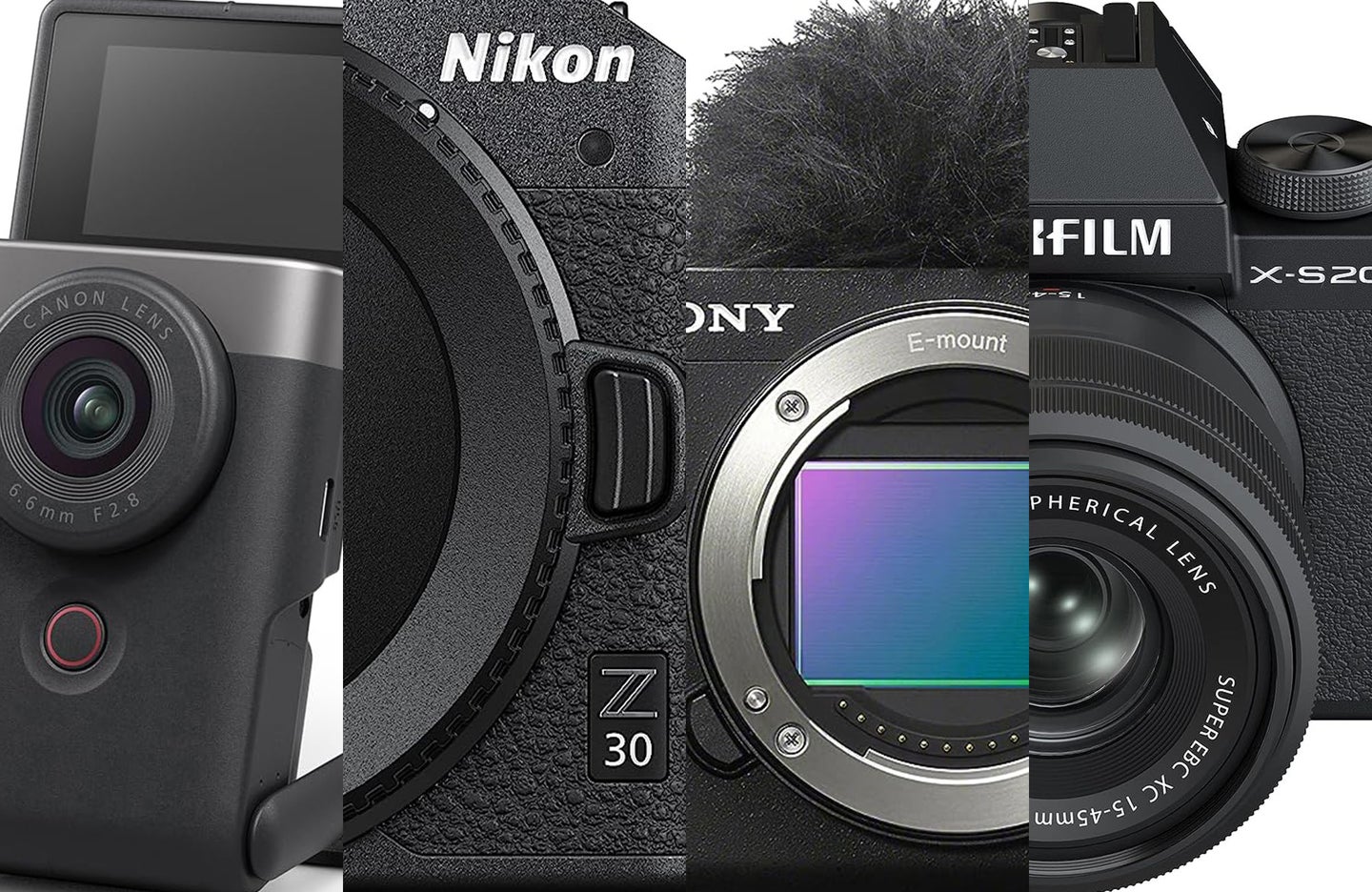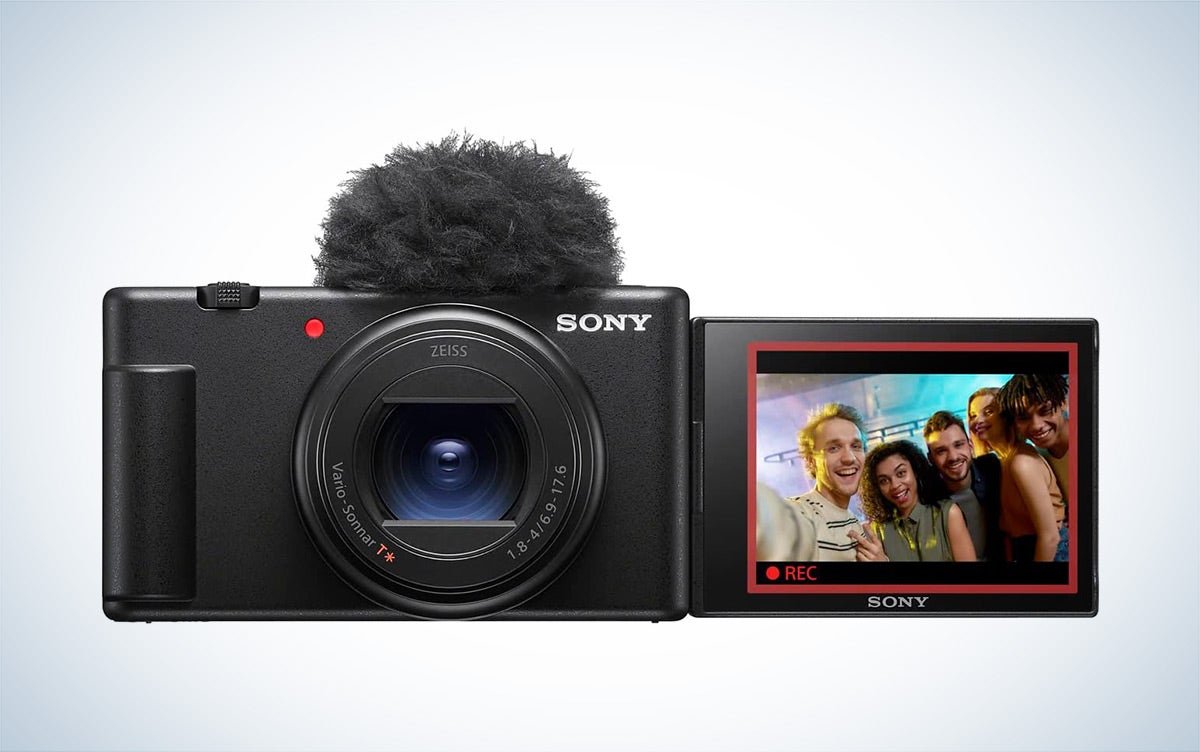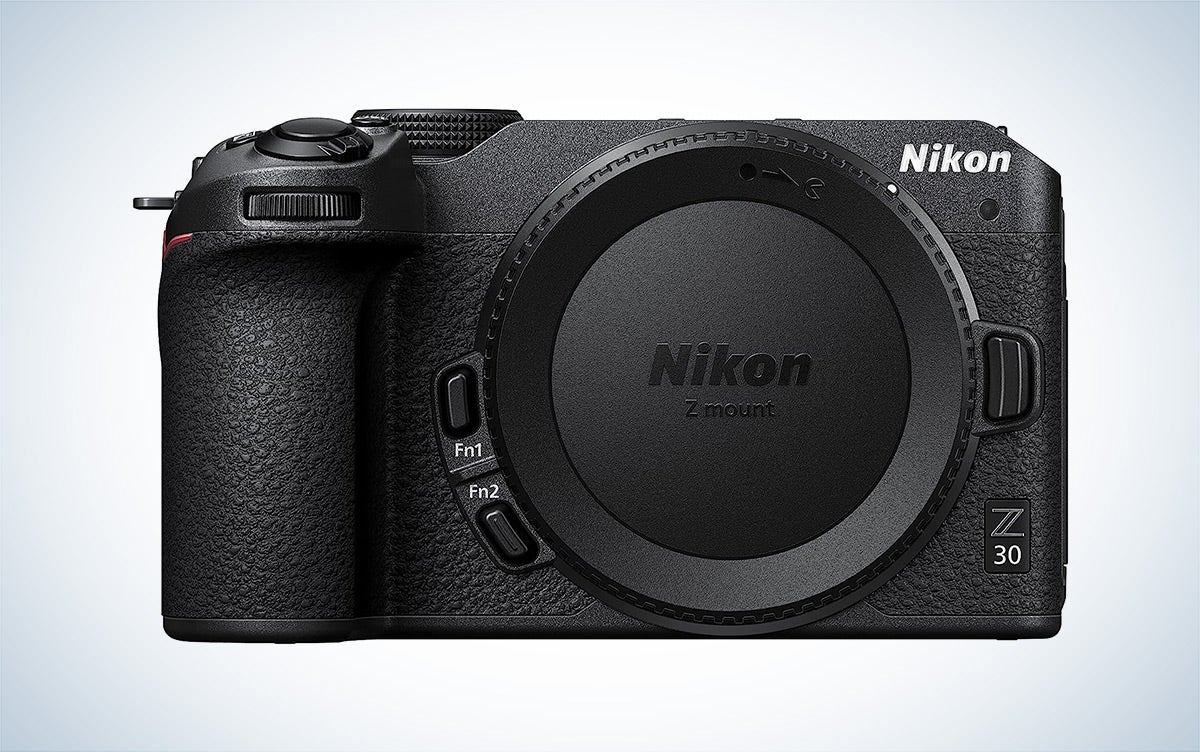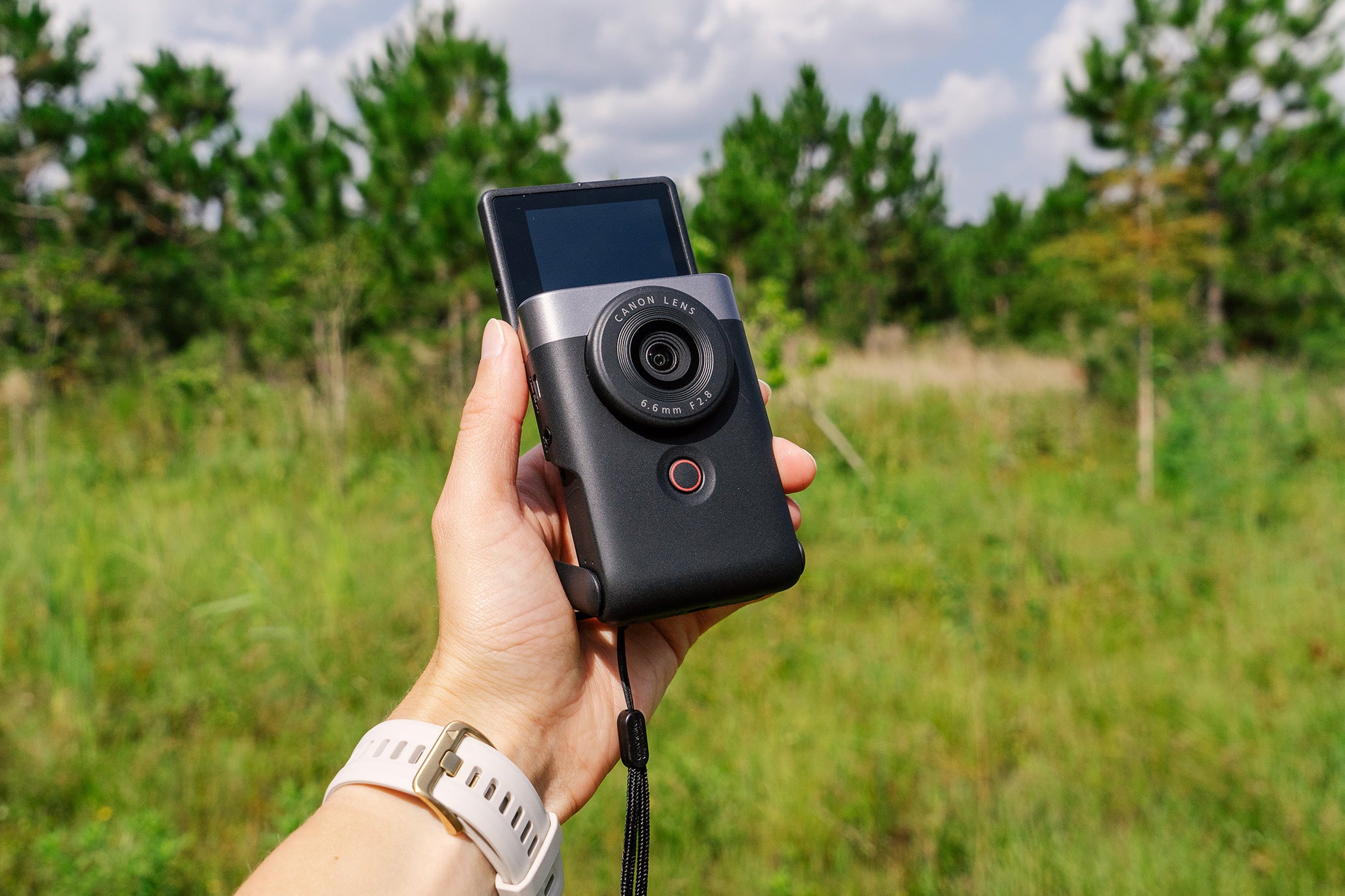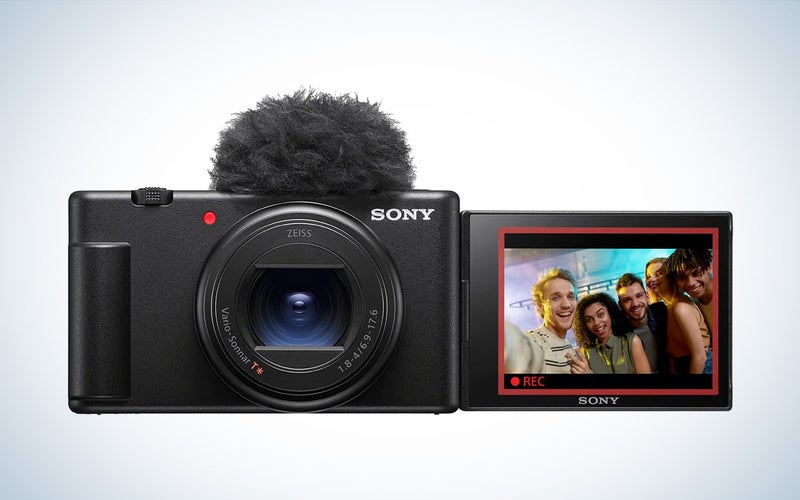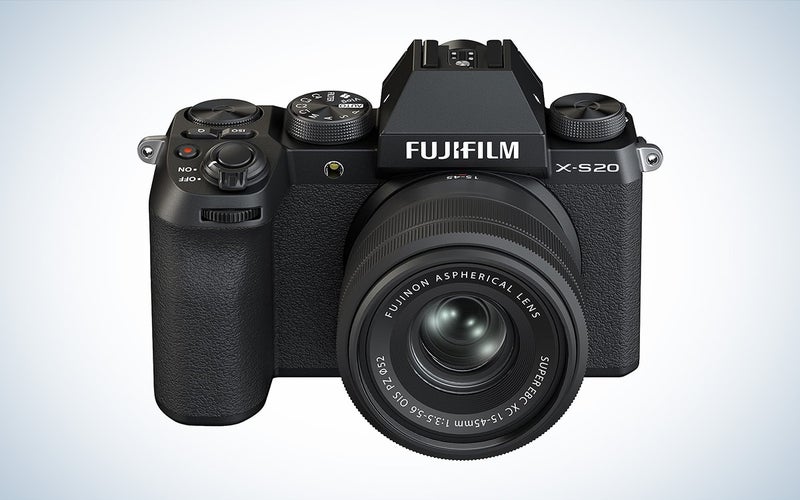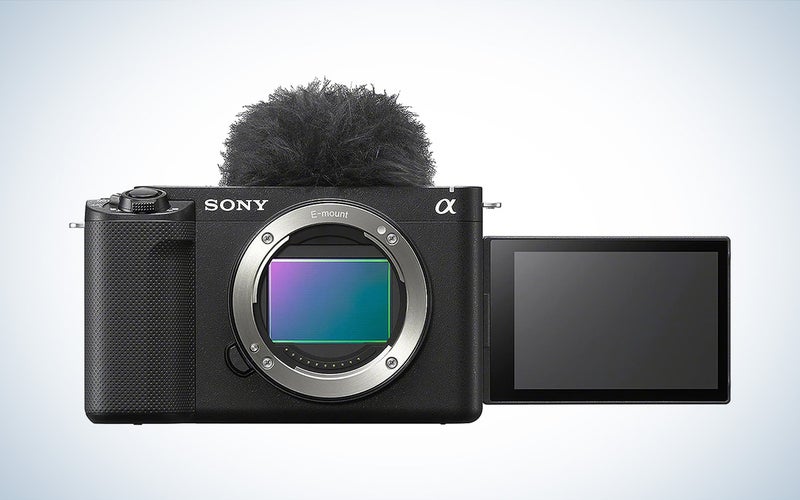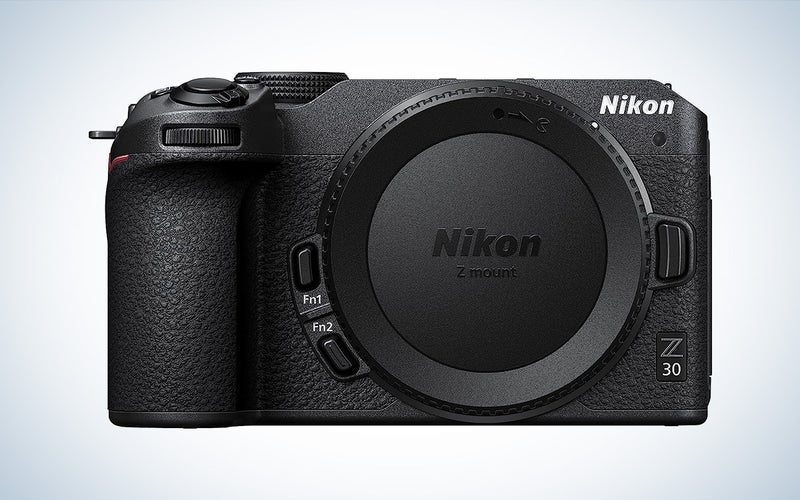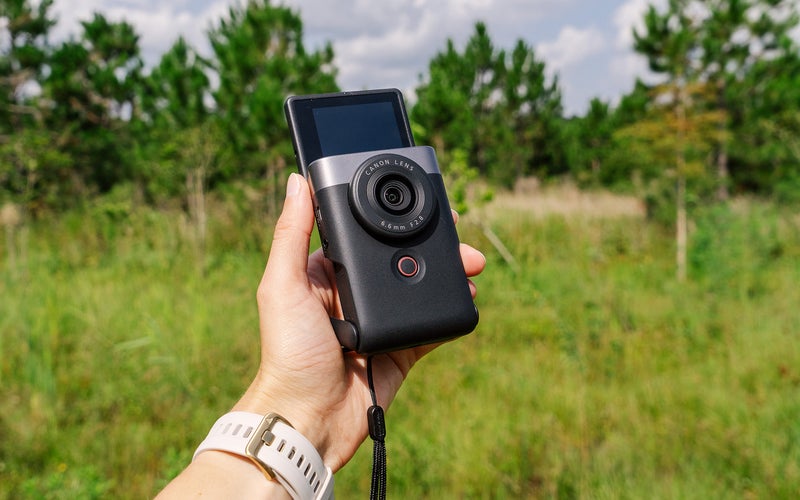We may earn revenue from the products available on this page and participate in affiliate programs. Learn more ›
The list of vlogging cameras has exploded in recent years, with most camera manufacturers focused on pieces of gear intended for this genre. These image-making devices take many shapes and forms, from compact cameras and action cams to high-end hybrid models meant for photo and video. It can be easy to get lost in all the noise and overwhelmed by the choices. What is best for you comes down to the type of content that you are making and your experience level. But no matter what, the best vlogging cameras will help you produce quality content reliably so you can continue to grow your audience.
- Best overall: Sony ZV-1 II
- Best with flip screen: Fujifilm X-S20
- Best for YouTube: Sony ZV-E1
- Best for travel: Nikon Z30
- Best budget: Canon PowerShot V10
How we chose the best vlogging cameras
Choosing a vlogging camera requires a very specific set of considerations that differ from cameras intended for other purposes. That’s in part due to the fact that the shooter is also typically the star.
When making our selections, we prioritized video quality, autofocus abilities, microphone quality, and stabilization options. Vari-angle displays with easy-to-use touchscreen functions were also important to us, as they make recording yourself significantly easier. Finally, we looked at additional features such as battery life, recording limits, and photography quality as well. We relied on a mix of hands-on experience, editorial reviews, and user feedback in narrowing down our list of cameras included here.
The best vlogging cameras: Reviews & recommendations
What should you look for when buying a vlogging camera? For starters, you’ll want an option with high-quality audio (like an external mic input), accurate and reliable autofocus, and Wi-Fi and Bluetooth connectivity. These are non-negotiables in a good vlogging camera. Beyond that, if you’ll be out and about rather than vlogging from a fixed location, you’ll likely want a small kit that’s easy to carry. Keep reading to discover other features that may be important, as well as cameras that could tick your necessary boxes.
Best overall: Sony ZV-1 II
Sony
Specs
- Resolution: 20.1-megapixels
- Sensor size: 1-inch
- Lens mount: N/A (integrated 18-50mm equivalent lens)
- Image stabilization: Digital (video only)
- Memory card slots: Single slot: SD/SDHC/SDXC
- Weight: 10.3 ounces
- Dimensions: 4.15 x 2.4 x 1.84 inches
Pros
- Very compact and lightweight
- Plenty of vlog-friendly features
- Integrated fast lens with versatile focal length
- Fully articulated touchscreen
Cons
- No optical or in-body stabilization
- Battery life isn’t great
The ZV-1 II is Sony’s second take on its extremely popular vlogging camera. This compact camera features an integrated 18-50mm (full-frame equivalent) lens, which means you don’t have to invest in separate glass or bring more gear along on shoots. The wide-angle perspective is ideal for recording yourself at arm’s length or capturing broad views when traveling. And the f/1.8-4 maximum aperture improves low-light performance and allows you to get attractive bokeh when trying to highlight a person or product.
Sony’s cameras are well known for their impressive autofocus, and that remains the case here. The ZV-1II offers Real-Time Eye AF and Real-Time tracking, which quickly and precisely focus on and track your subject. It also features a Product Showcase setting for smoothly transitioning focus from a face to an object when you need to show off a product.
Another big benefit of the SV-1 II is the quality of the multidirectional three-capsule mic. The camera can orient this mic towards faces and objects when in auto mode, offering even better sound. Should you want even better audio, you can take advantage of the 3.5mm microphone port and Multi Interface Shoe and add on a shotgun mic. The camera is very lightweight, making it easier to bring with you and to hold, even for long filming sessions.
Best with flip screen: Fujifilm X-S20
Fujifilm
Specs
- Resolution: 26.1-megapixels
- Sensor size: APS-C
- Lens mount: Fujifilm X
- Image stabilization: Sensor-Shift, 5-Axis
- Memory card slots: Single slot: SD/SDHC/SDXC (UHS-II)
- Weight: 1.1 pounds
- Dimensions: 5 x 3.4 x 2.6 inches
Pros
- Excellent battery life
- Built-in attractive film simulations
- Versatile vari-angle touchscreen
- Advanced video capture modes
Cons
- Not weather-sealed
Fujifilm’s X-series of mirrorless cameras draw acclaim for a reason, and the X-S20 makes a top-notch vlogging camera. For starters, it features one of the best hand grips of any camera we researched, without any of the bulk of a DSLR. That makes it a lot easier to hold without purchasing a separate cage or gimbal. It also offers seven stops of stabilization to smooth out your vlogs when shooting handheld.
The vari-angle touchscreen is a big plus for vloggers, as it facilitates any angles that you’ll need when shooting, even if that means holding the camera really low or really high. The viewfinder is a bit small for a camera of this size, but most vloggers won’t be recording through that anyway. If you want to shoot still photos with this camera, you’ll be pleased as well, thanks to the excellent photo quality. It’s even capable of up to 20 fps burst shooting for capturing action.
Perhaps most importantly, the X-S20 offers a wide range of video quality and aspect ratios. You can record in open gate 6.2K 30p with a 3:2 aspect ratio, which provides more flexibility for cropping in post or using anamorphic lenses. You can also shoot in 4K 30p or 4K 60p with a slight crop. The video quality overall is excellent, with nice levels of detail. And you can take advantage of Fujifilm’s attractive film presets if you don’t want to fuss with editing.
Best for YouTube: Sony ZV-E1
Sony
Specs
- Resolution: 12.9 megapixels
- Sensor size: Full-frame
- Lens mount: Sony E
- Image stabilization: Digital, 5-Axis
- Memory card slots: Single slot: SD/SDHC/SDXC (UHS-II)
- Weight: 1.1 pounds
- Dimensions: 4.8 x 2.8 x 2.1 inches
Pros
- Exceptional stabilization
- Great in low-light situations
- Excellent video features and quality
- Advanced, AI-powered autofocus
Cons
- Not great for photos
Sony’s ZV-E1 is perhaps the best vlogging camera out there. However, it doesn’t earn our top spot because its higher price, more advanced features, and interchangeable lens system aren’t ideal for a big segment of vloggers. But, if you want the ability to produce high-quality content for YouTube, this is the best option for you.
This full-frame vlogging camera is capable of 4K recording up to 120p or full HD up to 240p. Internal 10-bit 4:2:2 sampling is possible in all recording modes, and there are no recording limits. Sony improved heat dissipation in this camera, and it should offer up to 60 minutes of recording time at 4K60p.
Sony designed this camera specifically for vloggers, and the result is a long list of features ideal for filming your YouTube videos. That includes 15+ stops of dynamic range, advanced color control with S-Cinetone and the ability to import your own LUTs, class-leading stabilization, and cinematic bokeh. It also offers powerful AI-based autofocus, such as the ability to recognize and track multiple subjects in the frame and auto-framing options to keep the subject in the frame. It is a seriously impressive camera for those who want to get serious with their vlogs.
Best for travel: Nikon Z30
Nikon
Specs
- Resolution: 20.8 megapixels
- Sensor size: APS-C
- Lens mount: Nikon Z
- Image stabilization: Digital (video only)
- Memory card slots: Single slot: SD/SDHC/SDXC (UHS-I)
- Weight: 12.3 ounces (body only)
- Dimensions: 5 x 2.9 x 2.3 inches
Pros:
- Compact and lightweight
- Good for photos and videos
- Uncropped 4K video
- Reliable autofocus
Cons
- Only offers digital stabilization
The Nikon Z30’s compact size makes it an ideal choice for travel vlogging. But, despite the small body, it offers a robust grip, which provides a better, more comfortable hold on the camera. It doesn’t offer a viewfinder, but most will be fine with the three-inch vari-angle touchscreen anyway. An added bonus is that when you flip the screen around, the camera automatically changes to selfie mode and reliably tracks your face.
From a video perspective, the Z30 is capable of 4K 30p video or full HD at p to 120p for slow-motion footage. It allows continuous recording of just slightly over two hours, so you can record long takes when touring a location on your travels. You can even live stream at up to 4K 30p. Nikon built the camera with a high-quality stereo mic and also included a 3.5mm mic port if you want to use an external option.
If you also want to take stills on your travels, the Z30 is an ideal choice in large part thanks to Nikon’s impressive image quality and color science. The 20.8-megapixel sensor will result in nicely detailed images with good noise handling and low-light performance. It can shoot up to 11 fps bursts for those times you want to document action. And it offers a selection of built-in presets and filters so that you can skip the editing and share right to your desired platforms, making it an ideal beginner vlogging camera as well.
Best budget: Canon PowerShot V10
Abby Ferguson
Specs
- Resolution: 13.1 megapixels
- Sensor size: 1-inch
- Lens mount: N/A (integrated lens)
- Image stabilization: Digital
- Memory card slots: Single slot: microSD/microSDHC/microSDXC (UHS-I)
- Weight: 7.4 ounces
- Dimensions: 3.5 x 2.5 x 1.4 inches
Pros
- Very tiny
- Built-in stand is handy
- Easy to use with simple controls
- Integrated ND filters
Cons
- Lens gets dirty easily
- Doesn’t offer much room to grow
If you are looking for a basic, affordable vlogging camera, the Canon PowerShot V10 is a great choice. This unique camera is very tiny, making it easy to keep in your pocket and record a vlog whenever inspiration strikes. It features an integrated 19mm lens (full-frame equivalent), which is plenty wide for selfie videos or small groups of people. And the small rear screen flips up to help you frame your shots when recording yourself.
The budget-friendly price of this camera does mean that it isn’t groundbreaking in terms of quality or features. It’s capable of 4K up to 30p or full HD up to 60p with reasonable detail and colors. You can easily record vertical video simply by rotating the camera on its side. I found that the two stereo mics and a third mic that filters background noise do a good job of producing quality audio, even when I was outside on a windy day.
One of the things I liked about the V10 is its simplified menu system. You don’t have to fuss with settings and figure out what all the options mean, which is ideal for beginners. The built-in stand is also really nice for recording without a tripod or using it to hold the camera. It’s not a perfect device and can’t compete with more expensive vlogging cameras, but the affordable price and beginner-friendly features make it a good choice for many. If you want to read more about the PowerShot V10, check out our full review.
What to consider when looking for the best vlogging cameras
The list of suitable vlogging cameras is long these days, making it challenging to choose one. They come in all sorts of form factors with many different features, making each camera suitable for a different type of vlogger. Overall, the best vlogging camera features a rotating screen, is able to use an external mic, and suits your particular budget, lifestyle, and vlog goals. Beyond that, here are some key things to look out for when selecting the best vlogging camera for you.
Camera type
Vlogging cameras come in many different shapes and sizes, so you’ll want to put some thought into what fits your lifestyle and vlogging plans best. Many vlogging cameras are compacts (sometimes called point-and-shoots), which utilize an integrated lens. These are small devices, and since you won’t need to worry about bringing extra lenses, they are ideal for those on the go or traveling a lot for their vlogs. However, the single, built-in lens can be limiting and may prevent you from getting what you want stylistically.
The range of interchangeable lens cameras designed for vlogging has expanded significantly in recent years. In fact, most mirrorless cameras offer at least some vlogging-focused features. These cameras come in both APS-C and full-frame varieties. There are pros and cons with each format, and what is best for you comes down to goals, preferences, and budget. It’s important to consider a camera that you can grow into but isn’t so advanced that you won’t use most of the features until the camera is outdated and needs to be replaced.
Broadly speaking, APS-C cameras are more affordable and smaller but are typically a bit limited in features and overall quality. Full-frame cameras are ideal for more experienced vloggers wanting to take their content to the next level, but they come with a higher price tag as a result.
Rotating screen
Unless you have a YouTube entourage to help make your videos, you’ll likely be filming yourself. That requires a high-quality screen that flips around to face the front of the camera so you can see what your shot looks like. Most vlogging cameras feature vari-angle screens now, but there are still considerations within the screens: Whether the screen flips open to the side or above the camera, if the screen can rotate on additional angles, the size of the screen, the durability of that screen connection, etc.
Size
Most people recording vlogs do so, at least in part, in locations other than a studio or office. That typically means you are holding the camera up instead of using a tripod, and of course, means you have to lug it around with you. As a result, you’ll want a vlogging camera that is relatively compact and lightweight. This is even more important if you travel frequently, as carrying around a bulky camera on worldwide adventures is never fun.
The camera grip is also an important factor here if you ever plan on manually holding the camera (for a walk-and-talk or whatever it may be) and not exclusively using a tripod. A tiny camera may be lighter to hold up, but if it doesn’t offer a good grip, it won’t be comfortable to hold. Not only will it prevent you from dropping the camera, but it’ll ensure that your footage isn’t wobbly.
FAQs
Q: What is the best camera for vlogging for beginners?
The best vlogging camera for beginners depends on your goals. If it’s to experiment with vlogging without too much commitment, we recommend the Canon PowerShot V10. If it’s ease of use, we recommend our choice for the best overall vlogging camera, the Sony ZV-1 II, for its mid-level price point, its improved audio without an external mic, and its overall performance that doesn’t demand too much technical know-how to get right.
Q: What should I look for when buying a vlogging camera?
The most important features to look for when buying the best vlogging cameras are the ones that improve sound, video quality, and ease of use. Namely, an external mic input, great autofocus, and a rotating screen.
Q: Are GoPros good for vlogging?
If you’re looking for adventure, know you’ll be out in the elements (whether that’s poolside or mountainside), want something truly pocket-size, and—most critically—don’t care if you can see what you’re filming as you do, GoPros can be great. We’d generally recommend a GoPro as an add-on to your vlogging equipment, as they don’t (and were not designed to) replace a full camera.
A final word on shopping for the best vlogging cameras
- Best overall: Sony ZV-1 II
- Best with flip screen: Fujifilm X-S20
- Best for YouTube: Sony ZV-E1
- Best for travel: Nikon Z30
- Best budget: Canon PowerShot V10
The best vlogging cameras let you focus on the content of the vlog rather than an overly complicated camera set-up or interface, and makes you look and sound better while doing it. For most users, a vlogging camera with a flip screen is the best. For low-light, interchangeable lenses, and better stills, look for a full-frame camera. And whether you’re looking for a video camera for YouTube or the best camera for travel vlogging, pay attention to the f-stop and focal length of the lens based on your needs, and do not — ever! — forget to look for a better mic, and an external mic input. Vlog on, now: The camera loves you.
Why trust us
PopPhoto has a long history of delivering the opinions of some of the sharpest and most prolific camera dorks the world has to offer. Since 1937, we’ve been reviewing cameras, providing wisdom from well-known photographers, and generally just nerding out about all that goes into making great pictures. Our current crop of writers and editors have decades of professional photography and camera writing experience among them. Collectively, we’ve probably shot with just about every camera and lens combo you can imagine—as well as some obscure stuff you may not even know about. Remember the Casio Tryx folding camera? PopPhoto does.
We also get that buying a camera is a big decision, which is why we’re dedicated to helping folks choose the right one (or, in our case “ones”) for their needs. Case in point: Handing over top dollar for an expensive rig may leave you unsatisfied if it doesn’t fit your preferred shooting style. Sure, a $6,000 sports-oriented DSLR can capture landscapes, but do you really need to do it at 30 frames-per-second? No, you don’t.
